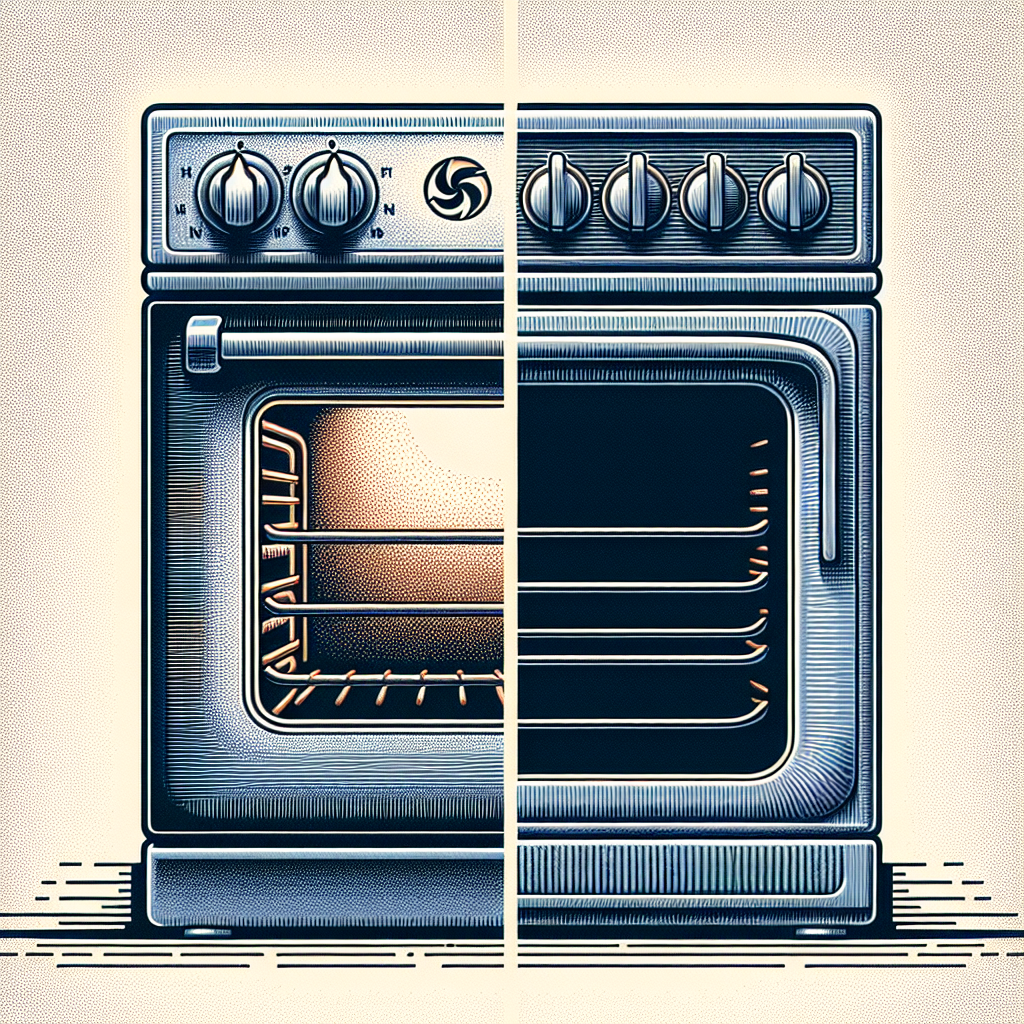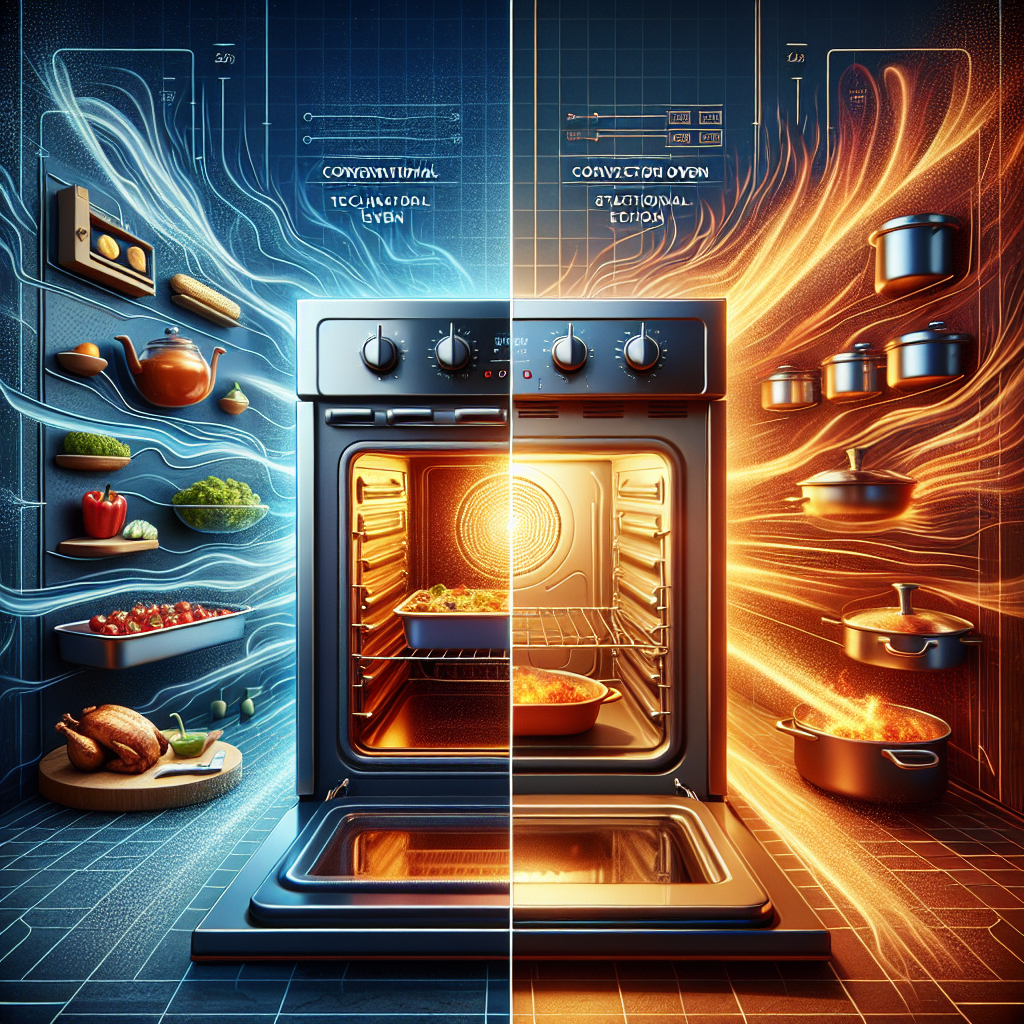What’s The Difference Between A Convection Oven And A Conventional Oven?
November 21, 2023

Ever wondered why your baked goods sometimes come out differently depending on the oven you use? Well, the answer might lie in the type of oven you’re using. So, what’s the difference between a convection oven and a conventional oven? While both can bake and roast your favorite dishes, a conventional oven relies on radiant heat to cook food evenly, whereas a convection oven uses a fan to circulate hot air, resulting in faster and more even cooking. Join us as we explore the distinctions between these two popular kitchen appliances, and discover which one might be the better fit for your cooking adventures.

Definition of Convection Oven
A convection oven is a type of oven that uses a fan to circulate hot air evenly around the food. This circulating hot air helps to cook the food more quickly and evenly compared to a conventional oven. The fan in a convection oven helps to distribute the heat and ensures that the temperature is consistent throughout the cooking process.
How does a convection oven work?
In a convection oven, the fan is located at the back of the oven and helps to circulate the hot air inside. As the fan blows the hot air around, it creates a convection current that surrounds the food. This convection current helps to transfer heat more efficiently to the food, resulting in faster cooking times and more even cooking.
What are the benefits of using a convection oven?
Using a convection oven offers several benefits. Firstly, it greatly reduces cooking time. The circulating hot air in a convection oven means that food cooks faster, which is especially helpful when you are in a hurry. Additionally, the even heat distribution in a convection oven ensures that there are no hot spots or cold spots in your food, resulting in more consistent and evenly cooked meals.
Another benefit of using a convection oven is that it allows for better browning and crisping. The circulating hot air helps to create a beautiful golden brown color on the surface of dishes, such as roasted meats or baked goods. This added benefit of browning and crisping gives your dishes a more visually appealing and appetizing look.
Are there any drawbacks to using a convection oven?
While convection ovens have many advantages, there are also a few drawbacks to consider. One potential drawback is the learning curve associated with using a convection oven. Since the cooking time is shorter, it can take some time to adjust cooking times and temperatures to ensure that your food is not overcooked. It may require some experimentation to find the right settings for different recipes.
Another drawback is the initial cost of purchasing a convection oven. Compared to conventional ovens, convection ovens tend to be more expensive. However, considering the time saved and the improved cooking results, many people find the investment worth it.
Definition of Conventional Oven
A conventional oven, also known as a traditional oven, is the standard type of oven that most people are familiar with. It uses heating elements located at the top and bottom of the oven to generate and distribute heat.
How does a conventional oven work?
In a conventional oven, the heating elements are responsible for producing heat. The upper heating element is typically located in the top of the oven, while the bottom heating element is located at the bottom. These elements heat up, and the heat rises, creating a natural convection current inside the oven. The hot air in the oven then cooks the food.
What are the benefits of using a conventional oven?
One of the main benefits of using a conventional oven is its simplicity. Conventional ovens are easy to use, and the temperature settings are straightforward. They are also generally more accessible in terms of price compared to convection ovens. If you are on a budget or prefer a more traditional cooking method, a conventional oven is a great option.
Are there any drawbacks to using a conventional oven?
Conventional ovens have some drawbacks. One of the main drawbacks is their slower cooking time compared to convection ovens. Due to the absence of a fan for circulating hot air, the heat distribution in a conventional oven can be uneven, resulting in uneven cooking. This can be particularly noticeable when baking, as some areas of the baked goods may be more cooked than others.
Another drawback is the limited browning and crisping ability of conventional ovens. Achieving a perfect golden brown crust on dishes can be challenging in a conventional oven due to the slower cooking process and less even heat distribution. You may need to use different techniques or additional methods, such as broiling, to achieve the desired browning and crisping.
Heating Mechanism
Heating elements in a convection oven
In a convection oven, the heating element is typically located near the fan at the back of the oven. The fan helps to distribute the heat generated by the heating element evenly throughout the oven. This combination of the heating element and the fan ensures that the entire oven cavity reaches the desired temperature quickly.
Heating elements in a conventional oven
In a conventional oven, there are two heating elements – one at the top and one at the bottom of the oven. These heating elements heat up and radiate heat into the oven cavity. The heat rises, creating a natural convection current that cooks the food. However, since there is no fan to circulate the hot air, the heat distribution can be less consistent compared to a convection oven.

Cooking Time
Cooking time in a convection oven
Cooking time in a convection oven is generally shorter compared to a conventional oven. The circulating hot air helps to cook the food faster and more evenly. It is essential to monitor the cooking process closely when using a convection oven, as the shorter cooking time can result in overcooked or burnt food if not timed properly. It is advisable to adjust the cooking time according to the recipe or consult a convection oven cooking guide for reference.
Cooking time in a conventional oven
Cooking time in a conventional oven is typically longer compared to a convection oven. The slower cooking process due to the absence of a fan means that it takes more time for the heat to penetrate the food and cook it thoroughly. It is important to follow the recipe’s suggested cooking time and periodically check for doneness to avoid undercooking the food.
Temperature Distribution
Temperature distribution in a convection oven
A convection oven offers a more even temperature distribution throughout the oven cavity due to the circulating hot air. This even temperature distribution ensures that the food cooks uniformly, with no hot spots or cold spots. It allows for consistent cooking results and reduces the risk of unevenly cooked dishes.
Temperature distribution in a conventional oven
In a conventional oven, the temperature distribution can be less consistent compared to a convection oven. The heat rises from the heating elements, creating a variation in temperature throughout the oven cavity. The top of the oven tends to be hotter than the bottom, which can result in uneven cooking. It is recommended to rotate dishes or use baking sheets to help distribute heat more evenly in a conventional oven.
Browning and Crisping
Browning and crisping in a convection oven
A convection oven excels at browning and crisping food. The circulating hot air helps to create a more even browning on the surface of dishes, such as roasted meats, vegetables, and baked goods. The combination of the fan and the even heat distribution results in a beautiful golden brown color and a crispy texture, enhancing the overall appearance and flavor of the dish.
Browning and crisping in a conventional oven
Achieving perfect browning and crisping in a conventional oven can be more challenging. Due to the slower cooking process and less even heat distribution, it may be necessary to use additional methods, such as broiling or increasing the cooking time, to achieve the desired browning and crisping. Baking pans with a darker color or using specialized pans designed for browning can also help improve the results.
Size and Space
Size and space considerations for a convection oven
Convection ovens are available in a range of sizes to accommodate different cooking needs. However, it is important to consider the available space in your kitchen before purchasing a convection oven. Convection ovens tend to be larger and require more space than conventional ovens. Ensure that you have enough counter space or a suitable area to install the convection oven before making a decision.
Size and space considerations for a conventional oven
Conventional ovens also come in various sizes to suit different kitchen spaces. However, they are generally more compact and take up less space than convection ovens. If you have limited kitchen space or prefer a smaller oven, a conventional oven may be a more suitable option.
Energy Efficiency
Energy efficiency of a convection oven
Convection ovens are generally considered to be more energy-efficient compared to conventional ovens. The shorter cooking time in a convection oven means that it uses less energy overall. Additionally, the even heat distribution and reduced need for preheating contribute to energy savings. However, it is still important to consider the energy consumption of the specific model and brand of convection oven you choose, as energy efficiency can vary.
Energy efficiency of a conventional oven
Conventional ovens are not as energy-efficient as convection ovens. The longer cooking time and the need to preheat the oven contribute to higher energy consumption. However, newer models of conventional ovens have become more energy-efficient with technological advancements. It is advisable to look for energy-efficient models if opting for a conventional oven.
Ease of Use
Using a convection oven
Using a convection oven may require some adjustment and experimentation, especially if you are accustomed to using a conventional oven. It is important to follow the manufacturer’s instructions and learn how to adjust cooking times and temperatures for optimal results. Once you get familiar with using a convection oven, it can be just as easy to use as a conventional oven, if not easier.
Using a conventional oven
Conventional ovens are known for their simplicity and ease of use. They typically have straightforward temperature settings and do not require much adjustment. If you prefer a more traditional cooking experience without the need for advanced settings or additional considerations, a conventional oven may be the more user-friendly option.
Price Range
Price range of convection ovens
Convection ovens tend to be more expensive compared to conventional ovens. The added benefits of faster cooking times, even heat distribution, and improved browning and crisping contribute to the higher price point. However, there are a variety of convection ovens available in different price ranges, allowing you to choose one that fits your budget and specific needs.
Price range of conventional ovens
Conventional ovens generally have a wider price range, making them more accessible to different budgets. They are available in various models and sizes, allowing for a greater range of prices. Whether you are looking for a basic conventional oven or a more advanced option, there are options available to suit different price points.
In conclusion, convection ovens and conventional ovens have distinct differences in terms of cooking mechanism, cooking time, temperature distribution, browning and crisping abilities, size and space considerations, energy efficiency, ease of use, and price range. Understanding these differences can help you make an informed decision when choosing between a convection oven and a conventional oven based on your cooking preferences, needs, and budget.
